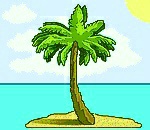
 |
itsislandtime > Krakatoa > Krakatoa Information | |
| itsislandtime.com | ||
|
Krakatoa |
|||||||||||
By Beachcomber, retrieved from Wikipedia Nov 3, 2003, 17:50 Krakatoa (Indonesian name: Krakatau) is a volcano on the Indonesian island of Rakata in the Sunda Strait. It has erupted repeatedly, massively and with disastrous consequences throughout recorded history, but the most well known of these events occured on August 26, 1883. Before its final catastrophic eruption Krakatoa had lain dormant until May 20, 1883, when it erupted. By August 11, three vents were regularly erupting on the volcano. During this time tides were unusually high, and phenonema such as windows suddenly shattering were commonplace. Ships at anchor were sometimes tied down with chains as a result. The August 26 eruptions occurred at 5:30 am, 6:42 am, 8:20 am and 10:02 am local time. The lattermost was the loudest and most destructive one, and could be heard from locations in Australia 2200 miles away, and even from 3000 miles away, on the island of Rodrigues near Mauritius. It is believed that this explosion is the second loudest noise ever heard by modern humans (the loudest is believed to have been generated during the 1815 eruption of Mount Tambora, also in the Indonesian archipelago. Although no one is known to have been killed as a result of the initial explosion, the tsunamis it generated had disastrous results, killing some 36,000 people (some sources say 36,417), and wiping out a number of settlements, including Telok Batong in Sumatra, and Sirik and Semarang in Java. An additional 1000 or so people died from the effects of volcanic fumes and ashes. Ships as far away as South Africa rocked as tsunamis hit them, and the bodies of victims were found floating in the ocean for weeks after the event. There are even numerous documented reports of groups of human skeletons floating across the Indian Ocean on rafts of volcanic pumice and washing up on the east coast of Africa up to a year after the eruption. The 1883 eruption was amongst most severe volcanic explosions in modern times (VEI of 6, equivalent to 200 megatons of TNT). Concussive air waves from the explosions travelled seven times around the world, and the sky was darkened for days afterwards. The island of Rakata itself largely ceased to exist as over two thirds of its exposed land area was blown to dust, and its surrounding ocean floor was drastically altered. Two nearby islands, Verlaten and Lang, had their land masses increased. Volcanic ash continues to be a significant part of the geological composition of these islands. The eruption produced exotic sunsets throughout the world for many months afterwards, as a result of sunlight reflected from suspended dust particles ejected by the volcano high into Earth's atmosphere. Interestingly, researchers in 2004 proposed the idea that the blood red sky painted as a background to Edvard Munch's famous 1893 painting The Scream accurately depicts the sky as it appeared in Norway after the 1883 eruption of Krakatoa. It has been suggested that an eruption of Krakatoa may have been responsible for the global climate changes of 535-536. Additionally, in recent times, it has been argued that it was this eruption which created the islands of Verlaten and Lang (remnants of the original) and the beginnings of Rakata - all indicators of that early Krakatoa's caldera size, and not the long-believed eruption of approx 416 CE, for which conclusive evidence does not exist. Indeed, it has been argued by Winchester (see Sources below), that the book which chronicles this possible event, the Javanese 'Book Of Kings', completed in the 1680's, may have been embellishing the truth, or even a complete fiction. Since the 1883 eruption, a new island volcano, called Anak Krakatau ("Child of Krakatoa"), has formed in the caldera. Of considerable interest to volcanologists, this has been the subject of extensive study since 1960. Additionally, it has also been studied as a case study of island biogeography and founder populations in an ecosystem being built from the ground up, virtually sterilized, certainly with no macroscopic life surviving the explosion. However, the island is still active, growing at the rate of five inches (12.7 cm) per week. Krakatoa was the name of a short 1933 movie about the volcano which won the Academy Award for Best Short Subject, Novelty for its producer Joe Rock. This movie was also notable for overwhelming the sound systems of the cinemas of the time. In Australia, the distributors insisted on a power output of 10 watts RMS as a minimum for cinemas wishing to show the movie. This was then considered a large system, and forced many cinemas to upgrade. The eruption is also the subject of a 1969 Hollywood film entitled Krakatoa, East of Java starring Maximilian Schell - which is notable chiefly for getting the volcano's location embarrassingly wrong; Krakatoa is in fact west of Java. Click here for the full Wikipedia article.
|